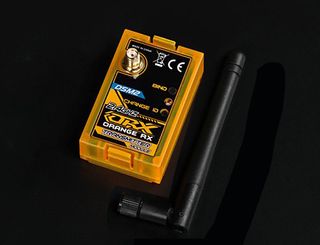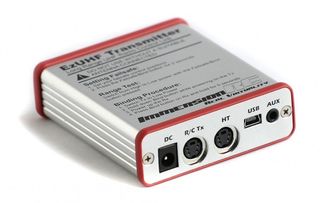Multi-Rotors, First-Person View, And The Hardware You Need
Control Systems
The second radio system on an FPV multi-rotor is, of course, the control system. Again, both a transmitter and receiver are needed, and the choice of frequency is an important one. There are generally fewer frequencies available for control systems. Most common is 2.4 GHz, though 35 MHz and 72 MHz were popular in the past, also. UHF systems are becoming increasingly prevalent, and we'll discuss those in more detail, too.

Transmitters are available either as a single unit or, less commonly, as modular pieces. When you buy the transmitter shell, sticks, knobs, and switches on their own, without radio hardware, you then need a transmitter module to emit your inputs. Enthusiasts with multiple models communicating over different frequencies often find this approach useful, since it's easy to swap out modules. The Turnigy 9XR is an example of a quality, inexpensive modular transmitter.

Deciding on a frequency for control follows the same principles as video. You get better penetration from lower frequencies, and again, the same wavelength cannot be used for FPV and control. Additionally, frequencies with matching harmonics are discouraged because you'll still get interference. A 1.2 GHz video signal will conflict with 2.4 GHz control for example, since the radio waves share nodes.
As you shop around for transmitters, pay particular attention to the number of channels they offer. For each remote-controllable action, a unique channel is needed to convey input. The minimum required to pilot a multi-rotor is four channels: throttle, yaw (rotation), pitch, and roll. For every flight mode switch, gimbal control, or lighting control, an extra channel is involved. Most flight controllers are going to recommend eight channels; the more you support, though, the greater your opportunities for customization and upgrades.
On the other end of the control system is a receiver with a corresponding frequency. Of course, the number of receiver channels has to match the transmitter if you want to utilize all of the available functions. Each channel has a pinout that is connected using a servo cable to the appropriate component. The four stick outputs, at least, must be fed to the flight controller in order to control a multi-rotor.

There are two protocols for control transmission. The first and most traditional is pulse-code modulation (PCM), a standard analog one-to-one broadcast. It remains both reliable and popular. But increasingly, hobbyists are adopting an alternative: pulse-position modulation (PPM). With PPM, multiple inputs are encoded and transmitted using a single channel. It is advantageous in that it reduces wiring and setup difficulty, allowing for more channels than previously possible. Both schemes work, and neither is deemed more correct than the other. However, not all transmitter/receiver combinations support PPM.
The newer UHF solutions mentioned previously are fundamentally similar to other control systems. However, they operate across a range of frequencies (usually 130 to 135 MHz) and use channel hopping to maintain a strong link for as long as possible. Generally, UHF transmitters are housed in external cases attached to a conventional transmitter using a trainer port. At such low frequencies and relatively high power, UHF systems are considered standard for long-range applications, with connections reaching out several miles and passing through obstacles with comparative ease.
Stay on the Cutting Edge
Join the experts who read Tom's Hardware for the inside track on enthusiast PC tech news — and have for over 25 years. We'll send breaking news and in-depth reviews of CPUs, GPUs, AI, maker hardware and more straight to your inbox.

There are various brands of UHF equipment, such as DragonLink and ImmersionRC EzUHF. All facilitate the same functionality, though some are more compatible with certain transmitters. You can expect to pay more for a UHF-based setup, and it might not even add anything to your FPV experience. Enabling such long range is unnecessary for anyone piloting small quads or flying in more confined spaces. Moreover, lower-power transmitters are preferable to maintain transmission balance and prevent conflict.
Current page: Control Systems
Prev Page Video Systems: Antennas And Goggles Next Page Give It A Go; You'll Love The View-
gio2vanni86 Great article, and quite an amazing beautiful video shot at the end. Been seeing these around, and have really loved the idea of filming at a elevated level. I actually do hope you guys do more of these. I am bookmarking this for future reference. Thank you.Reply -
freiss Darn it, now you've piqued my interest. :-)Reply
As stated below, a rundown on build costs would be nice. Hey, you could even do a series of FPV articles akin to the PC builds...budget, mid-range, and enthusiast! -
Steveymoo So, how much would the components cost to lift a heavy DSLR with some decent glass? I is pretty curious.Reply -
es0 It would be awesome if you did build guides for different aircraft. I have begun building different ground based vehicles using arduinos and Pi's and would love to take to the skys next!Reply -
thechief73 Excellent article, nicely explained. Also glad to see someone in the media make a clarification from drones and multi-copters.Reply
FYI, DO NOT CALL THESE DRONES: Drones are for military use to kill people. These are, as the authors title states: multi-copters, multi-rotors, or RC model aircraft. By using the word "Drone" you give all the uneducated fear mongers and the law writers canon fodder to regulate this hobby into oblivion before it really gets a chance to take off. Some states and other countries have already passed laws that almost or outright make this hobby a CRIME!
I have been in the hobby about a year now and I have to say it is so far one of the most fun and rewarding things I have done. I will be doing this until I no longer have the means to do so. I highly recommend anyone that is interested in joining the hobby to buy a Hubsan X4 or one of the many similar RTF mini-quad models. This is widley regarded as the best way to learn how to fly a multi-rotor.
http://www.youtube.com/user/juz70/videos - not my channel, just really neat.
So, how much would the components cost to lift a heavy DSLR with some decent glass? I is pretty curious.
Just a few options: DJI S1000, SkyJib-8 Ti-QR, and CINESTAR-8.
It would be awesome if you did build guides for different aircraft. I have begun building different ground based vehicles using arduinos and Pi's and would love to take to the skys next!
Check out youtube, there are thousands of guide videos on the subject.
-
HKILLER i would highly recommend these 2 for those who that don't want to go through the trouble of the build and already have an smart device such as iphone or android ones...Reply
http://www.newegg.com/Product/Product.aspx?Item=N82E16886113011&cm_re=parrot-_-86-113-011-_-Product
and this cheaper model of it....
http://www.newegg.com/Product/Product.aspx?Item=N82E16814998083&cm_re=parrot-_-14-998-083-_-Product -
rmirwin2 There is one other regulating authority which is important to keep in mind for those seriously interested. In the US that would be the FCC, since transmission of quality RC and video signals over the available frequencies requires a Technician's class Amateur radio license. Many will find that a relatively easy thing to get that will also maximize the enjoyment of the hobby. Check in with ARRL.org, where you can get everything you need.Reply -
bluescrn Great intro to multicopters. But for beginners, it's best not to start out with a serious $500+ quadcopter, as there's a pretty good chance that you'll wreck it on it's first flight...Reply
Do yourself a favour and get a 'toy grade' mini quadcopter first, such as the Hubsan X4/Q4 Nano or similar. These are cheap, loads of fun, can be flown indoors, are much safer than the big ones, and are a great way to learn to fly a multicopter. Spend a couple of hours playing with one of these, and you'll significantly reduce the time/money spent on crash repairs when you start flying a more serious multicopter. -
bluescrn Oh, and if you go down the ready-to-fly route (or even if you self-build), try not to be the next idiot losing control of a DJI Phantom in a location where they shouldn't have been flying at all ( e.g. https://www.youtube.com/watch?v=_U8iHn_2l0U )Reply
Stick to quiet and safe flying locations, be aware of wind, line-of-sight, and possible sources of RF interference. And don't rely too much on GPS/return-to-home - you might not have a GPS lock when you need it (or it might not have had a lock at take-off, to determine the home position!)
